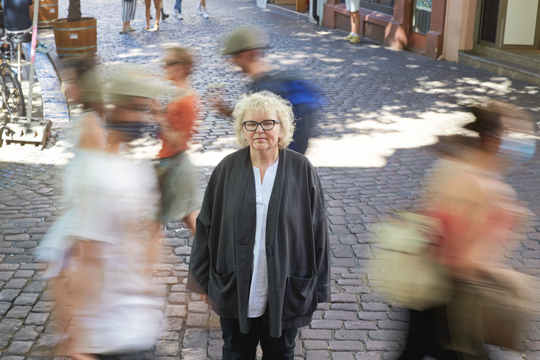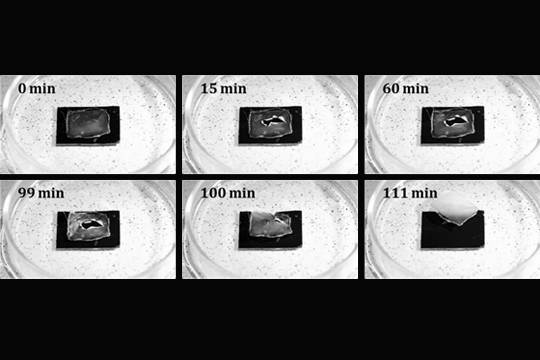Finding words for the space between nature and technology
Freiburg, Jul 20, 2020
Plastics in the oceans, chemical toxins in groundwater and other evidence of human activity are omnipresent in what’s now known as the Anthropocene - the age in which humans became the biggest factor affecting the global ecosystem. This blurs the line between the natural and the artificial. Can life-like material systems be considered phenomena of this epoch? Are such systems the right way to respond to the problems of the Anthropocene? And under what circumstances are people even willing to accept new technologies? Freiburg philosopher Professor Lore Hühn is working on these questions in the livMatS – Living, Adaptive and Energy-autonomous Materials Systems excellence cluster.
 Human footprints in the Anthropocene: The philosopher Lore Hühn explores the shifting boundaries between the natural and the artificial. Photo: Harald Neumann
Human footprints in the Anthropocene: The philosopher Lore Hühn explores the shifting boundaries between the natural and the artificial. Photo: Harald Neumann
“Materials never die,” says Lore Hühn from the Philosophy Department at the University of Freiburg. Are materials therefore immortal? As a member of the livMatS cluster of excellence, Hühn has been reflecting philosophically on its goals from the very beginning - the development of living, adaptable and energy-autonomous materials systems. “The cluster is highly topical, partly because we discuss classical philosophical questions - in the context of the age we are living in, the anthropocene.” What does adapting, learning, living mean in terms of materials? When do people embrace such new developments positively, when negatively? Where does nature end and technology begin? “These fundamental questions of natural philosophy are the core issues of our time,” she says. The answers are intended to help avoid the negative consequences of new technologies.
Can materials live?
Currently, Hühn is working on language: “I often come across distorted semantics,” she says. When humanities researchers speak of “life,” they usually mean something different from what natural science researchers mean. One thing is clear: materials break up, crumble, decompose - but they do not die. Can materials then “live” at all, as the “living” in livMatS suggests? Can they “heal” themselves as planned? “We discuss these questions in workshops,” says Hühn. Participants from the natural sciences and humanities explain how they interpret terms like “autonomy,” “adaptation,” “healing” and “living.” “One consideration, for example, is whether it is better to speak of 'lifelike' materials,” Hühn explains. Instead of ‘healing themselves,’ the material systems that we are striving for might one day ‘repair’ themselves.
The discussion inevitably leads to fundamental questions of philosophy. Where, for example, does the boundary between nature and technology run today? “In the Anthropocene, the classic division no longer applies,” says Hühn. The term “Anthropocene” refers to the current geological epoch. It contains the ancient Greek word for man, who has left footprints everywhere and irreversibly - in deep layers of the earth, the seas, soils, mountains and the atmosphere. Microplastics, nanoparticles and other man-made substances can be found in animals and plants on land and in water. Conversely, livMatS develops materials with properties that are inspired by nature and sustainable. Can the natural and the technical, the animate and the inanimate, be sharply differentiated from one another?
Plastic continents in the Pacific
“I'm also working on the ethical implications,” says Hühn. For example, what do people today understand by “autonomy,” “adaptivity” and “nature”? Do these terms always have positive connotations and associations with pleasant ideas? If their values and valuations shift, there are social consequences. Hühn says it is crucial to anticipate this as early as possible: “If the humanities are excluded from technological developments and are not involved from the very beginning, it can lead to the disasters that uppermost in our minds today. She cites the plastic masses floating in the Pacific: “We can't get them back out of the sea again.” Another project in the cluster focuses on environmental sustainability. Hühn is interested in social and ethical sustainability - the many social aspects that livMatS touches on. For example, the acceptance of a technological development in which paradigms are rapidly shifting. Today, public acceptance also requires an element of environmental friendliness.
 Metamorphosis in 111 minutes: Researchers at the livMatS cluster of excellence are working on materials which can shed their skins like snakes. Lore Hühn is focusing on the question of how such characteristics - where nature meets technology - can be described in relevant language. Source: Jürgen Rühe/University of Freiburg
Metamorphosis in 111 minutes: Researchers at the livMatS cluster of excellence are working on materials which can shed their skins like snakes. Lore Hühn is focusing on the question of how such characteristics - where nature meets technology - can be described in relevant language. Source: Jürgen Rühe/University of Freiburg
“We need to know what happens in people when we introduce new materials to the world,” Hühn emphasizes. livMatS has paved the way for its researchers to get a little closer to finding out. “No other cluster of excellence with a technical orientation gives the humanities such a strong position,” she says. This is also an ideal environment for the training of early-career researchers. The training builds bridges, is interdisciplinary, and some of it is international. In 2019, the University of Freiburg and the US’s Penn State University jointly founded a center for Living Multifunctional Material Systems; here too, ethical questions will flow into cooperative projects. And the discourse is to go yet further, says Hühn, “We also want to work closely with Japan.”
Shaking off old dualisms
Like all those in the new cluster of excellence, Hahn's projects are still in their infancy. In addition to the vocabulary workshops, close one-to-one talks, literature research and academic publications are already underway. Hühn and a postdoc from the ten-strong team in the humanities section of the cluster are working on the various perspectives existing in technology, biology and philosophy on the limits of life, autonomy, and adaptation. The group also wants to highlight current references to natural philosophy around 1800 and to the philosophies of technology of Martin Heidegger, Don Ihdes and Peter-Paul Verbeek.
“Not least, I would like to critically question basic convictions within my own discipline,” says Hühn, “I suspect that we are anachronistically orienting ourselves towards outdated concepts.” Her subject sticks to many of yesterday's dualisms: “Most of these opposites are long outdated,” Huhn says. She believes philosophy must tackle more contemporary, technical innovations to remain relevant in current debates on today’s iterations of natural philosophy.
“We want to teach on these topics and to learn about them,” says Hühn. “Ultimately I would like to see a cluster that is well versed in all aspects of sustainability, ethics and social acceptance.” They are supported in this by their livMatS cooperation partners Professor Rainer Grießhammer, Professor Andrea Kiesel, Professor Oliver Müller, Dr. Olga Speck, Dr. Philipp Höfele, Sabrina Livanec, Martin Möller and Lisa Reuter.
Jürgen Schickinger
livMatS – Living, Adaptive and Energy-autonomous Materials Systems
livMatS is one of the two Clusters of Excellence at the University of Freiburg. Its 25 working groups are developing nature-inspired materials systems which can adapt autonomously to varying conditions and can harvest clean energy from their surroundings. Further groups are in the pipeline. The researchers come from six faculties - the Faculty of Engineering, the Faculty of Chemistry and Pharmacy, the Faculty of Biology, the Faculty of Mathematics and Physics, the Faculty of Economics and Behavioral Sciences, and the Faculty of Humanities. The Fraunhofer institutes for Solar Energy Systems ISE and for Mechanics of Materials IWM, and the Oeko-Institut are participating. The German Research Foundation (DFG) is sponsoring the Cluster from the start of 2019 to the end of 2025.
livMatS
Further articles in this series:
The artificial trap
Intelligent aircraft wings could save fuel
A small, sharp eye

